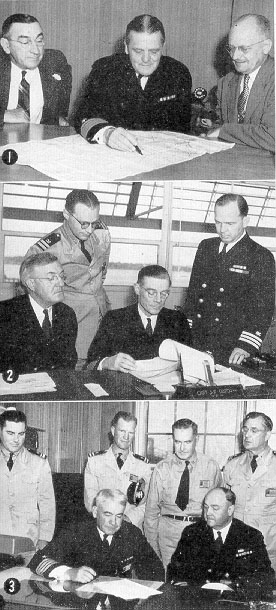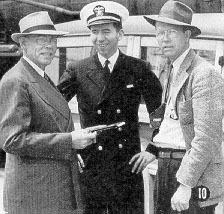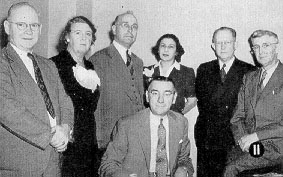A. T. Mercier, New SP President, Began As Clerk, Transit Man
 ARMAND THEODORE MERCIER, who thirty-eight years ago entered Southern Pacific service as a transitman and clerk to a roadmaster at Los Angeles, on December 11 was elected president of the Company at a meeting of the board of directors in San Francisco. He was also named a director and a member of the executive committee. Mr. Mercier had been a vice president since 1938.
ARMAND THEODORE MERCIER, who thirty-eight years ago entered Southern Pacific service as a transitman and clerk to a roadmaster at Los Angeles, on December 11 was elected president of the Company at a meeting of the board of directors in San Francisco. He was also named a director and a member of the executive committee. Mr. Mercier had been a vice president since 1938.In his long service with Southern Pacific, he has had broad experience in all phases of the railroad's far-flung operations. As an engineer, he personally supervised the building of many of the railroad's important structures. As an operating man, he served both as division superintendent and as general manager of the operating department. In the executive and administrative field, he has headed a number of Southern Pacific subsidiary companies as well as working closely, as vice president, with the late President A. D. McDonald during the past three years.
Wide Acquaintanceship
Always interested in the people with whom he has worked, Mr. Mercier is credited with knowing as many of the thousands of employes of the railroad by name as any man in the Southern Pacific organization.
A native of New Orleans and son of the late Dr. C. S. Mercier, he was educated in New Orleans public schools, Rugby Academy and Tulane University, graduating in 1903 as a civil engineer.
He came west in 1904 to join the railroad as transitman and road-master's clerk, and has since devoted his entire career to Southern Pacific service. Shortly he became a gang foreman. In 1906 he was made an assistant engineer and actively participated in the huge project undertaken by the railroad at the request of President Theodore Roosevelt to save the Imperial Valley and city of Yuma from Colorado River flood damage.
Early in 1907 he was named general foreman and engineer of bridges and buildings, in charge of steel bridge construction, with headquarters in Los Angeles, and later the same year he was appointed engineer and general foreman in charge of terminal construction work at San Pedro and Los Angeles.
Division Officer
A year later he was assistant division engineer of the Los Angeles Division, in 1911 assistant district engineer of the southern district, in 1912 division engineer of the San Joaquin Division, and in 1913 division engineer of the Los Angeles Division. In 1917 he was appointed assistant superintendent of the Shasta Division, and a year later became superintendent of the Portland Division.
In 1921 Mr. Mercier was named general manager of the San Diego & Arizona Railway at San Diego, and in 1929 president and general manager of that company. Two years later he became vice president and general manager of the Pacific Electric Railway at Los Angeles, the largest interurban electric rail system in the world.
He returned to the parent Southern Pacific Company in 1933 as general manager, and in 1938 was elected vice president in the executive department.
Comment From the Press
Typical of the reaction of the press to Mr. Mercier's appointment to the presidency is the following excerpt from Railway Age magazine of December 13:
"The volume of traffic that the railroads will be called upon to carry, now that we are actively engaged in a 'shooting' war is, as yet, indeterminate, but one thing is certain-that with active warfare in the Pacific, the role of the Southern Pacific System will be a large one and its responsibilities will be great. Realizing this, it is especially significant that the Southern Pacific has chosen an operating man who knows how to 'keep the wheels rolling' to guide this vast transportation system. That will be Mr. Mercier's task and he is particularly well qualified for it by training and experience."
Says the Reno Gazette: "President Mercier knows his railroad from the roadbed up."
Inspiration for Youth
And from the Bakersfield Californian: "Many youths with the advantage of university education have expressed regret at the lack of opportunities in this land of ours despite the advantages of collegiate courses. They might well read the story of the life of Armand T. Mercier, who has just been elected president of the Southern Pacific Railroad. Opportunity and effort run hand in hand."
The San Jose Mercury-Herald observed that Mr. Mercier's "promotion to the chief office of one of the world's largest railroad systems comes after 38 years of distinguished service . . . and at a time when demands upon it require the utmost talent."
"Because he started his railroading career in this city 37 years ago," says the Los Angeles Times, "Armand T. Mercier will be in the eyes of many Angelenos one of those 'local boys who made good.' As directing head of a system of 16,000 miles with more than 70,000 employes, Mr. Mercier will have an important part in the nation's war efforts. He has the best wishes of this community as he takes over his great responsibility."
August, Page 12-13
Navy and SP Join Hands in Huge Traffic Job
SHIP ahoy, mates! Make way for those Victory Trains; the trains that Sailorman Jack Salem says (page 8) are so vital to our war effort; the trains that President Mercier says are the No. 1 concern of every SP'er.
No pictures of those Victory Trains pounding along the rails or being shunted speedily through busy freight yards grace these two pages, but pictured here with some of SP's traffic representatives are the principal officers of the Eleventh Naval District who direct in our Southern District the steady flow of men and materials that is creating ashore and afloat the mightiest Navy of all time. These SP men are just a few of the many who work closely with the Navy officers on the movements of personnel and freight into and out of the expansive naval establishments around San Diego, in the Long Beach-San Pedro-Wilmington area, and elsewhere in the Eleventh Naval District.
Just how much traffic SP is handling for the Navy in that territory is, of course, not being published. It's enough to say that nothing like it has ever happened before. Nor can we tell of the magnitude or location of some of the Navy projects to which SP and its Pacific Electric subsidiary do the major hauling, except that one of them is the $18,000,000 Fleet Operating Base on Terminal Island.
So, since we're not privileged to write about the naval activities now functioning in high gear, let's meet the men pictured on these pages who direct traffic movements and who match the SP fellows in being highly efficient, cooperative and friendly.
At the top of the page, left (1): Rear Admiral R. S. Holmes, commandant of the Eleventh Naval District, with headquarters at San Diego, consults a map in his discussion with General Passenger Agent George B. Hanson (right), and Thos. Fielding, traffic manager of the San Diego & Arizona Eastern and district freight and passenger agent for SP at San Diego. Admiral Holmes is another sailorman who liked SP's "The Victory Trains Come First" advertisement. (Page 9.) "It is interesting in its presentation of needed facts on the immediate necessity of moving men and material in the war effort," he wrote President Mercier. "An informed public will prove to be the most cooperative public. Southern Pacific is to be congratulated for service above and beyond its basic task of transportation."
(2) : Captain J. F. Hatch, supply officer, San Diego, and staff-Lieut. Commander W. Elliott (seated left), Lieut. R. D. Kingsbury (standing left), and Commander J. H. Skillman.
• (3): Captain Byron McCandless, commanding officer, U. S. Destroyer Base, San Diego, and staff: Commander E. W. Hawkes (seated right) ; standing, 1-r: Lieut. W. I. Quatlebaum, Lieut. E. L. Monagin, Lieut. H. E. Fish, Lieut. E. A. Cushman. • (4): Commander James P. Helm, disbursing and accounting officer, San Diego (seated center), with Mr. Fielding, left, and Miss Estelle McKenna, supervising clerk in charge of transportation, right. Standing, 1-r: Lieut. J. A. Scott, asst. disbursing officer; Bruce A. Adams and W. E. Rosendale, SP City passenger agents; Mrs. Daisy R. Tho'mas and F. J. Kuhry, of Comdr. Helm's office. • ( 5 ) : Commander Charles H. Breyer, disbursing officer at the U. S. Naval Training Station, San Diego (seated). Standing, 1-r: Yeoman Lawrence Linstrum, Miss Barbara Nieman, Mrs. Rose Kellenberger, Miss Patricia Pinkley, and Chief Storekeeper W. B. Hitchcock.
Top of the page (6): Commander M. T. Scanlon, supply officer at the Navy's Disbursing and Transportation Office, San Pedro, scans the names of SP and T&NO officers and recalls for General Freight Agent C. M. Biggs when he knew many of them in their "boot camp" days before they started to climb the railroad's ladder. Before he joined the Navy in 1903, Comdr. Scanlon worked four years for the SP Lines in Texas, first as an apprentice machinist at Houston and then for the Motive Power Department in the Houston General Office. He's still an enthusiastic "rail" and enjoys many delightful visits with his early-day SP friends.
(7): Complete rail and steam power facilities of the Pacific Electric Railway are closely linked with those of the SP in serving numerous naval establishments. At the left end of this group taken in front of the Long Beach Freight Station is H. P. Clark, SP-PE agent. (See picture 10 for other names.) • (8): In the Purchasing and Transportation office at San Pedro, Lieut. W. A. Lawrence (seated), officer in charge of freight, and Chief Storekeeper J. H. O'Reilly with, 1-r: John Linke, of DFA office; H. A. Hansen, city freight agent; and A. L. Morgan, district freight agent at San Pedro. • (9): Pacific Motor Trucking services augment those of the SP in direct service to the Navy Disbursing and Transportation warehouses at San Pedro, as well as elsewhere when trucking operations can expedite deliveries. • (10): City Freight Agent H. A. Hansen (left), LA District Office, with Lieut. V. F. Lyon, public relations officer, Naval Operating Base, Long Beach; and H, D. Paynter, traffic manager of Guy F. Atkinson and George Pollock companies, contractors for the huge Fleet Operating Base and other naval construction work in the Los Angeles area. • (II): Thos. Fielding (seated) with his freight staff at San Diego. Standing, l-r: D. L. McNaughton, chief clerk; Grace DeCunea, steno-clerk; L. D. Carroll, city freight and passenger agent; Lillian Rottman, steno-clerk; G. O. Culley, traveling freight agent; and J. W. Chapman, rate clerk.







November, Page 9
Head Man's Train
SP Had Major Job Handling President Roosevelt's Special
THE AFTERNOON of September 25, a special train carrying President Roosevelt and party reached Southern Pacific Lines at Portland. For the next five days the nation's chief executive lived almost exclusively on SP rails rounding out one of the most dramatic journeys in railroad history.
The President traveled over the Cascade Route to Oakland, making a brief stop at Mare Island. After inspecting the Navy Supply Depot and the Army Port of Embarkation in Oakland, he proceeded down the Coast Line into the Los Angeles area, where he visited war industries. From there he went to San Diego, returning to SP Lines via SD&AE and Inter-Cal. Ry., thence to El Paso and via T&NO beyond.
The manner in which the railroad handled the details of this wartime inspection tour by the commander-in-chief of the armed forces is reflected in a letter written by his secretary, Stephen Early. Mr. Early said in part: "I want to say to you and ... to the officials and employes of the railroad lines over which the President passed while he was making his tour of inspection, that never in the life of this record-breaking traveler has he moved from coast to coast, from border to border, with as much ease and comfort, rest or enjoyment. I know this to be a fact . . . because he himself voiced this opinion in much the same words when he left the train . . . making the last stop of an 8,396 mile almost continuous railroad trip."
Greatest Secrecy
Great secrecy surrounded every movement of the special train, but naturally many operating and traffic railroad men, moving the train over the lines, were on the inside of the story. That so comparatively few people throughout the nation knew of this epic journey until it was completed is a striking demonstration of railroaders' ability to SERVE IN SILENCE.
During the entire time the President's special was on Pacific Lines and subsidiaries, General Manager C. F. Donnatin and Asst. Vice President Claude E. Peterson were at hand to see that details of transportation were carried out to the letter. Chief Special Agent Dan O'Connell also rode the train on SP lines, as did all superintendents during the time it passed over their respective divisions. Thousands of SP'ers had a hand in the detailed preparation that preceded the President's trip and in the actual movement of the train, yet comparatively few knew the identity of the "No. 1 Man."
While SP had special agents on the train at all times during the movement over our lines, Frank Wilson, chief of U. S. Treasury Secret Service, had complete charge of the party's safe conduct. He had full cooperation of the Army at all points.
Every Precaution
Some inkling of the minute precautions taken can be gained from excerpts from the instructions to division superintendents: "Division engineers will proceed over the track the day prior to the train movement and locate themselves so as to be in touch with dispatchers and their own forces. • Section foremen on the day or days immediately prior to the train movement must cover every foot of their section and assure themselves of the track being in the very best possible condition. • No switching shall be done on yard or running tracks adjacent to the main track to be used by the Special for 20 minutes prior to passage of the Pilot Train or the Special. • All facing-point main track switches leading to spurs, or to seldom-used tracks, shall be spiked not less than one hour before due time of the special."
Final word on the movement over SP lines was expressed by General Manager Donnatin in a letter to the superintendents when he wrote: "The handling of this important train was a grave responsibility, particularly during these times. Mr. L. B. McDonald joins me in expressing to you, your staffs, and employes appreciation for a service and a duty well performed."
President's Specials are not a new, although an ever thrilling, experience for Chief Special Agent Dan O'Connell. The recent trip with President Roosevelt makes the eleventh time he has accompanied a presidential special train over SP lines: twice before with Franklin Roosevelt, twice with both Teddy Roosevelt and Hoover; once each with Taft, Wilson, Harding and Coolidge.
 Back to SP Bulletins
Back to SP Bulletins 